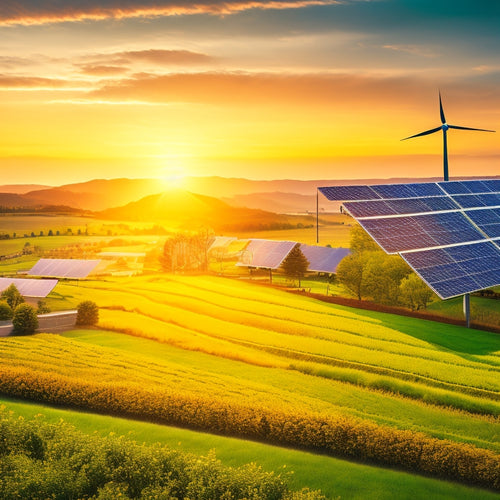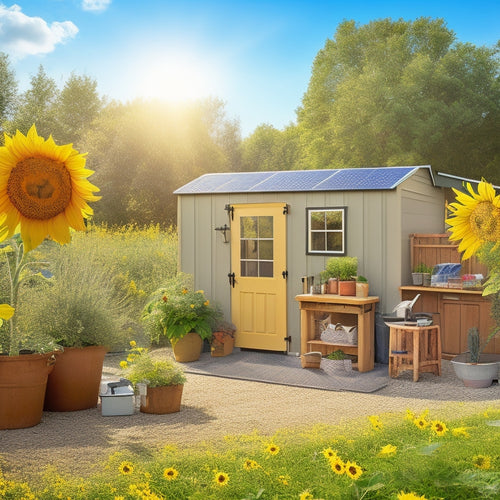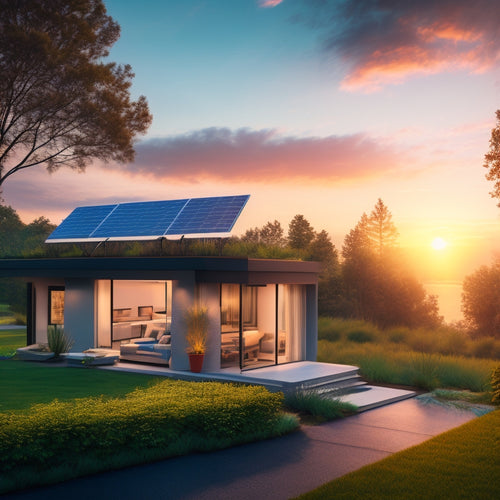
What's the True Cost of Going Green?
Share
You'll likely need to invest around $15,000 upfront to go green with a solar panel system, although costs vary widely depending on system size, equipment quality, and state-specific incentives. Installation prices range from $2.50 to $3.50 per watt, and energy storage solutions add another $5,000 to $15,000+ to the overall cost. While these numbers may seem overwhelming, understanding the subtleties of state-by-state cost comparisons, renewable energy incentives, and factors affecting installation costs can help you make an informed decision. As you investigate the true cost of going green, you'll uncover more details that can help you maximize your investment.
Overview
- The average cost of a solar panel system is around $15,000, with installation prices ranging from $2.50 to $3.50 per watt.
- Energy storage solutions, like batteries, can add $5,000 to $15,000+ to the upfront investment, depending on energy needs and grid integration.
- State-by-state costs and incentives vary significantly, with some states offering generous tax credits and renewable energy incentives to offset upfront costs.
- Installation complexity, local regulations, and contractor experience can impact overall costs, while regular maintenance is necessary to ensure efficient panel operation.
- While high upfront costs exist, benefits include reduced greenhouse gas emissions, potential savings on electricity bills, and government incentives, making going green a worthwhile investment.
Understanding Solar Panel Costs
Determine your solar panel costs by first understanding the upfront investment.
You'll need to evaluate the cost of the solar panels themselves, as well as inverters, mounting hardware, and installation. The average cost of a solar panel system is around $15,000, but prices vary depending on the size of your system and the quality of the equipment.
System size and complexity play a significant role in determining costs, as larger systems require more components and intricate system integration, raising costs exponentially system size and complexity.
Keep in mind that solar technology advancements have driven costs down over the years, making solar more accessible.
A typical solar panel lifespan is around 25-30 years, so while the initial investment may seem steep, it'll pay for itself over time.
Solar Panel Installation Prices
As you consider the overall cost of a solar panel system, installation prices play a significant role in your upfront investment.
You'll need to factor in the cost of labor, materials, and permits, which can range from $2.50 to $3.50 per watt, depending on the complexity of the installation and local regulations.
When designing and selecting your solar energy system, it's important to choose the right solar panels to guarantee peak energy production and reduce costs in the long run.
With the average residential solar panel system sized at around 5 kilowatts, that's a total installation cost of $12,500 to $17,500.
Fortunately, solar financing options are available to help spread the cost over time.
Be prepared for installation timelines that can range from a few days to several weeks, depending on the size of your system and the installer's workload.
State-by-State Cost Comparison
You'll find that the cost of going green varies substantially from state to state, thanks to differences in renewable energy incentives, green infrastructure costs, and state tax credits.
For example, states like California and New York offer generous incentives, while others like Mississippi and West Virginia have fewer benefits.
As homeowners shift to energy independence, they're turning to solar-powered battery backup systems that enhance energy independence, reduce reliance on fossil fuels, and guarantee a reliable power supply for critical infrastructure and essential services.
As you investigate the true cost of going green, understanding these state-by-state differences is vital to making informed decisions.
Renewable Energy Incentives
Renewable energy incentives vary widely from state to state, with some offering significant financial benefits to encourage the adoption of green technologies.
As you weigh the costs of going green, you'll want to evaluate the federal incentives that can help offset the upfront expenses. Long-term savings from energy efficiency and reduced energy consumption can also add up.
Additionally, renewable energy can provide environmental benefits, grid independence, and job creation opportunities. Policy impact and technology advancements are also key factors to evaluate.
For instance, states with strong renewable portfolio standards have seen a significant increase in clean energy production.
Green Infrastructure Costs
Green infrastructure costs vary greatly across states, and understanding these differences is essential to making informed decisions about investments in sustainable projects. You'll want to evaluate the upfront costs, maintenance expenses, and potential ROI when assessing green infrastructure options.
| State | Average Cost per Square Foot | Green Roof Benefits |
|---|---|---|
| California | $15-$25 | Stormwater management, energy efficiency |
| New York | $10-$20 | Urban heat island mitigation, air quality improvement |
| Texas | $8-$15 | Water conservation, habitat creation |
| Florida | $12-$22 | Flood protection, sustainable landscaping |
When investing in green infrastructure, you'll want to weigh the costs against the benefits, such as improved air quality, increased property values, and enhanced ecosystem services. By understanding the state-by-state costs, you can make informed decisions about which sustainable projects to prioritize.
State Tax Credits
Identify tax credits that can offset green infrastructure costs by comparing state-by-state incentives. You'll find that state financial incentives vary widely, affecting your bottom line.
For instance, California offers a 30% tax credit for renewable energy systems, while New York provides a 10% credit for green building projects.
You'll need to determine tax credit eligibility for your specific project. In Oregon, you'll qualify for a 35% credit for solar panels, but only if you've invested at least $2 million.
Meanwhile, Texas offers a 10% credit for wind energy systems, with no minimum investment requirement.
Researching these incentives will help you maximize your savings and make informed decisions about your green infrastructure investments.
Factors Affecting Installation Costs
Several factors influence the cost of installing eco-friendly systems, and understanding these variables is essential to accurately budgeting for your project. You'll want to take into account the installation complexity, system size, and equipment quality, as these can greatly impact the overall cost. Financing options, local regulations, and contractor experience also play a role. Additionally, your installation timeframe, utility rates, and site assessment can affect the final price tag.
| Factor | Impact on Cost |
|---|---|
| Installation complexity | Higher complexity, higher cost |
| Financing options | Better financing, lower upfront cost |
| Local regulations | Stricter regulations, higher cost |
Hidden Costs of Going Solar
When you invest in solar energy, you'll face high upfront costs that can be a significant financial burden.
Moreover, you'll need to factor in regular maintenance costs to guarantee your panels operate efficiently, as neglecting maintenance can lead to reduced energy output.
In addition, if you want to store excess energy for later use, you'll need to budget for expensive energy storage systems.
High Upfront Investment Costs
Your decision to go solar comes with a hefty price tag, as the initial investment in solar panels and installation can be staggering.
The upfront cost of solar panels, inverters, and installation can range from $15,000 to $30,000 or more, depending on the system size and quality. However, you can offset this cost with financing options, government policies, and installation incentives.
In the long term, you'll enjoy significant savings on your energy bills, potentially saving up to $500 per year. Additionally, going solar can increase your property values and contribute to a positive community impact.
With technology advancements and market trends driving down costs, now might be the perfect time to invest in energy independence and reap the environmental benefits.
Panels Require Regular Maintenance
By the time your solar panels are installed, you've already invested a significant amount of money. Now, you need to take into account the ongoing costs of maintaining them to guarantee peak performance.
| Maintenance Aspect | Details |
|---|---|
| Frequency | Every 6-12 months, depending on environmental conditions |
| Cleaning Requirements | Regular cleaning to prevent performance degradation (up to 25%) |
| Warranty Coverage | Typically 25 years, covering panel defects and performance issues |
| Repair Options | Contact the manufacturer or installation company for assistance |
Regular maintenance is essential to maximize your solar panels' efficiency and extend their lifespan (typically 30-40 years). Poor installation quality can lead to more frequent maintenance, while efficient monitoring helps identify issues early on.
Energy Storage Is Expensive
Energy storage, a vital component of going solar, comes with a hefty price tag that can surprise even the most informed consumers.
You'll need to invest in battery technology and storage solutions to guarantee a steady supply of energy when the sun isn't shining. The cost of these solutions can range from $5,000 to $15,000 or more, depending on your energy needs and grid integration requirements.
While energy storage can increase energy efficiency and provide long-term savings, it's crucial to contemplate the upfront cost.
Fortunately, market trends suggest that prices are decreasing, and financial incentives are available to offset the expense.
When assessing the environmental impact of going solar, remember that energy storage is a critical component of a reliable and efficient system.
Is Solar Energy Worth It?
Over 2 million solar panels are installed worldwide every month, making solar energy one of the fastest-growing renewable energy sources.
As you consider going green, you're likely wondering: is solar energy worth it? The answer lies in the numbers.
Solar energy benefits include a significant reduction in greenhouse gas emissions and energy independence.
With solar technology advancements, the cost of installation has decreased by over 70% in the last decade, making it more accessible to homeowners and businesses.
In fact, solar energy can save you up to $500 per year on your electricity bill.
With governments offering incentives and tax credits, the financial benefits of solar energy are clear.
Frequently Asked Questions
Can I Install Solar Panels on My Rental Property?
You can install solar panels on your rental property, but you'll need to contemplate the landlord's permission, local building codes, and potential rent increases to offset the costs, ensuring a mutually beneficial solar panel installation.
Do Solar Panels Increase My Property's Resale Value?
"Blood is thicker than water," but when it comes to resale value, solar panels can be the icing on the cake! You'll likely see an increase in property value, thanks to solar incentives and a higher property appraisal, increasing your rental's attractiveness to potential buyers.
Are There Any Solar Panel Recycling Programs Available?
As you consider solar panels' environmental impact, you'll find that recycling programs are emerging, focusing on reclaiming precious materials like silicon and metals at the end of their 25-30 year lifespan, leveraging innovative recycling technologies.
Can I Use Solar Panels to Charge My Electric Vehicle?
As you rev up your eco-friendly lifestyle, you're wondering if solar panels can fuel your electric vehicle. Yes, you can utilize the sun's power, but consider solar panel efficiency and electric vehicle compatibility to guarantee a seamless charge.
Are There Any Solar Panel Maintenance Requirements?
You'll need to perform routine maintenance to guarantee your solar panels operate at maximum efficiency; cleaning them every 6-12 months and inspecting for damage can help you maintain up to 95% efficiency, depending on your system's maintenance frequency.
Ready to Buy
You've weighed the pros and cons of going green, and now it's time to reflect on the bottom line. While the cost of solar panels has dropped considerably over the years, the average American still spends around $15,000 to install a solar energy system. However, did you know that for every dollar invested in solar, you can expect to save $1.50 in energy costs over the system's lifetime? That's a return on investment that's hard to ignore.
Related Posts
-

Net Metering in Renewable Energy's Future
Net metering's future is vital for driving renewable energy growth and financial savings. You can reduce your electri...
-

Building an Emergency Backup Solar Power System in 5 Essential Steps
Building an emergency backup solar power system involves five key steps. First, assess your daily energy needs to ide...
-

The Future of Residential Energy Storage
The future of residential energy storage looks promising and cost-effective for you. With lithium-ion battery prices ...


